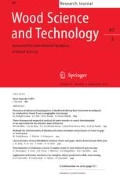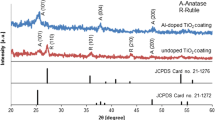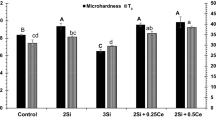Abstract
The aim of this research was to synthesize surface-treated nano-titanium dioxide (TiO2) particles and incorporate them into water-based acrylic systems, which could offer long-term protection for UV-sensible wood substrates. To suppress the photocatalytic activity, the surface of TiO2 nanoparticles in rutile crystal structure was coated with amorphous silica (SiO2) layer. The amounts of SiO2 were 5 and 10 wt%, respectively. Formation of SiO2 layer on TiO2 surface was analyzed using scanning and transmission electron microscopy. SiO2 layer thickness increases as a function of precursor loading. In addition, the influence of SiO2 loading on rutile UV-protective properties was determined. Transparent UV-protective coatings were developed by incorporating surface-treated nano-TiO2 into water-based acrylic stain. The particle size distribution was determined using dynamic light-scattering measurements, which indicate that the suspension of surface-treated rutile is stable against agglomeration. Furthermore, the color change and ability of protection against UV light of coatings after nanoparticles incorporation were determined. TiO2, surface treated with 10 wt% of SiO2, yielded coatings of higher transparency; however, TiO2, surface treated with 5 wt% of SiO2, improved UV protection.







Similar content being viewed by others
References
Ayadi N, Lejeune F, Charrier F, Charrier B, Marlin A (2003) Color stability of heat-treated wood during artificial weathering. Holz Roh-Werkst 61:221–226
Bae TH, Tak TM (2005) Effect of TiO2 nanoparticles on fouling mitigation of ultrafiltration membranes for activated sludge filtration. J Membrane Sci 249:1–8
Brock T, Groteklaes M, Mischake P (2010) Europran coatings handbook, 2nd edn. Vincentz Network, Hannover 123
Christensen PA, Diks A, Egerton TA, Temperley J (1999) Infrared spectroscopic evaluation of the photodegradation of paint—part I—the UV degradation of acrylic films pigmented with titanium dioxide. J Mater Sci 34:5689–5700
Godnjavec J, Znoj B, Venturini P, Žnidaršič A (2010) The application of rutile nano-crystalline titanium dioxide as UV absorber. Inf MIDEM:6–9
Hon DNS, Shiraishi N (2001) Wood and cellulosic chemistry, 2nd edn. Marcel Dekker Inc, New York
IFT Rosenheim directive (1999) HO.03.1999, 3.5 Prüfung der UV-Durchlässigkeit und Transparenz
Li QY, Chen YF, Zeng DD, Gao WM, Wu ZJ (2005) Photocatalytic characterization of silica coated titania nanoparticles with tunable coatings. J Nanopart Res 7:295–299
McCusker M (1999) A UVA/HALS primer: everything you’ve ever wanted to know about Light stabilizers. Met Finish 97:51–53
Mori T, Tanaka K, Inomata T, Takeda A, Kogoma M (1998) Development of silica coating methods for powdered pigments with atmospheric pressure glow plasma. Thin Solid Films 316:89–92
Nanetti P (2006) Coatings from A to Z. Vincentz Network, Germany, Hannover
Nuopponen M, Wikberg H, Vuorinen T, Maunu SL, Jamsa S, Viitaniemi P (2003) Heat-treated softwood exposed to weathering. J Appl Polym Sci 91:2128–2134
Nzokou P, Kamdem DP (2006) Influence of wood extractives on the photo-discoloration of wood surfaces exposed to artificial weathering. Color Res Appl 31:425–434
Pandey KK (2005) A note on the influence of extractives on the photo discoloration and photo degradation of wood. Polym Degrad Stabil 87:375–379
Powell QH, Fotou GP, Kodas TT, Anderson BM (1997) Synthesis of alumina- and alumina/silica-coated Titania particles in an aerosol flow reactor. Chem Mater 9:685–693
Schaller C, Rogez D, Braig A (2008) Hydroxyphenyl-s-Triazines: advanced multipurpose UV-absorbers for coatings. J Coat Technol Res 5:25–31
Sclafani A, Palmisano L, Schiavello M (1990) Influence of the preparation methods of titanium dioxide on the photocatalytic degradation of phenol in aqueous dispersion. J Phys Chem 94:829–832
Winkler J (2003) Production of titanium dioxide pigments. European Coatings Literature, Vincentz, pp 37–40
Zahri S, Belloncle C, Charrier F, Pardon P, Quideau S, Charrier B (2007) UV light impact on ellagitannins and wood surface colour of European oak. Appl Surf Sci 253:4985–4989
Author information
Authors and Affiliations
Corresponding author
Rights and permissions
About this article
Cite this article
Veronovski, N., Verhovšek, D. & Godnjavec, J. The influence of surface-treated nano-TiO2 (rutile) incorporation in water-based acrylic coatings on wood protection. Wood Sci Technol 47, 317–328 (2013). https://doi.org/10.1007/s00226-012-0498-3
Received:
Published:
Issue Date:
DOI: https://doi.org/10.1007/s00226-012-0498-3




